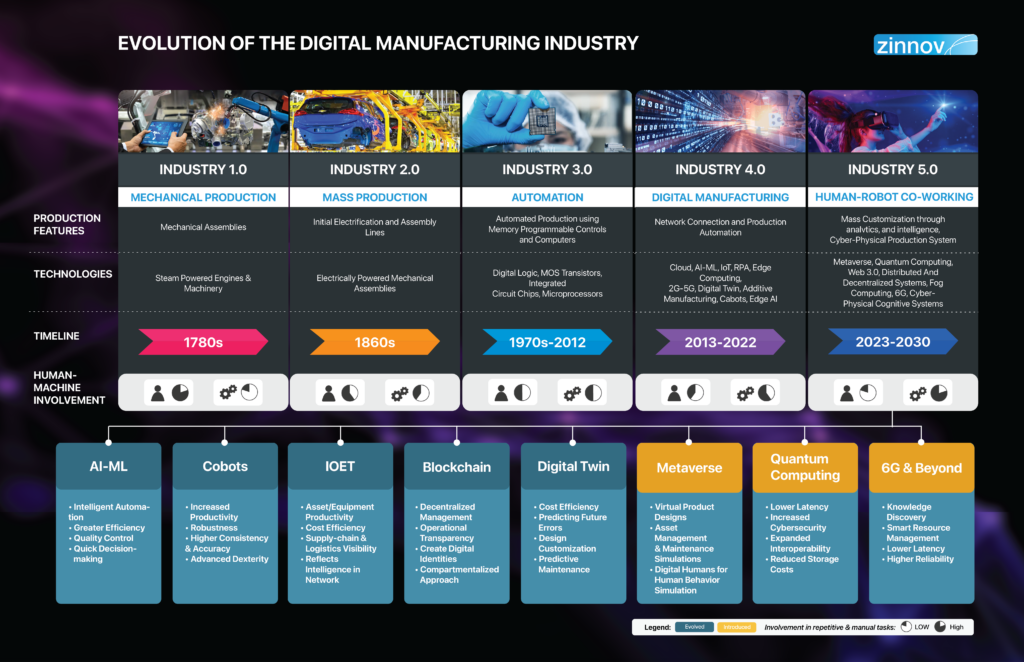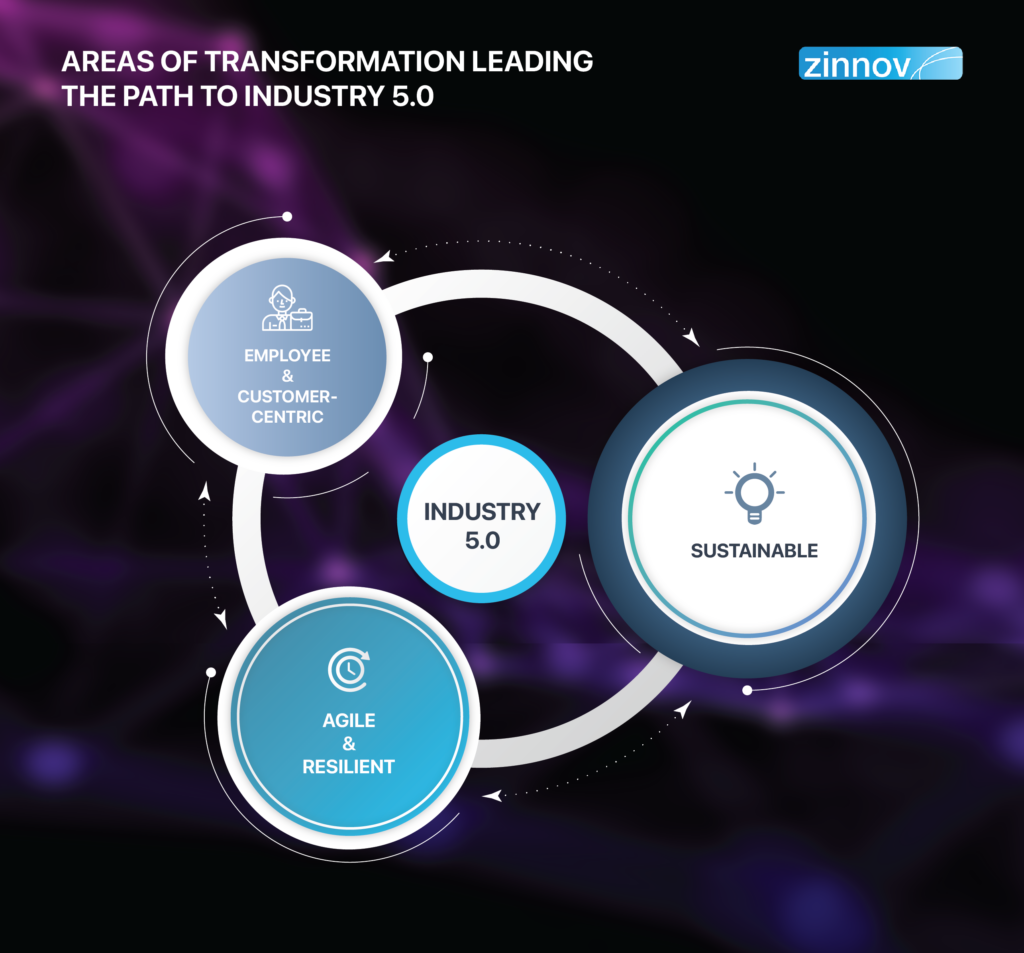|
|
Humans have undergone a drastic evolution, our existence has transformed every century and down each generation. One of the most significant shifts was when manual workmanship and craft traversed into automated processes. The present-day version of these processes has taken the avatar of the automated manufacturing sector by running agile factories and building smart warehouse systems.
The Manufacturing industry has evolved from Industry 1.0, 2.0, 3.0 to 4.0 and is now entering 5.0 Each phase represents important stages of Manufacturing after the Industrial revolution. A significant constant has remained the decreasing involvement on humans and reliance on machinery throughout each phase. Driven by the impact of the pandemic, the need for automation, virtualization, and resilience are emerging as key themes as we enter the new phase.
At the moment, we are on the brink of the fourth Industrial Revolution. This is characterized by Smart Manufacturing, where manufacturing processes are computer-integrated. This phase saw the introduction as well as the implementation of key technologies like Artificial Intelligence (AI) for smart decision-making, Machine Learning (ML) algorithms for identifying patterns in data, Robotic Process Automation (RPA) for back-office high-volume repetitive tasks, Digital Twins for equipment/facility insights throughout their lifecycle, Collaborative Robots (Cobots) for assembly line automation and heavy lifting, and Connectivity evolution from 2G-5G for faster communications.
In the next phase of transformation, Industry 5.0 is expected to bring about human-robot co-working dynamics which means maximized automation and minimal human interaction. This relationship will be instrumental in transitioning existing smart factories to a lights-out factory. These will be designed to sustain an entirely robotic workforce with negligible employee intervention. Arising from this will be saved energy consumption and electricity downsizing. Another key theme to cement the presence of Industry 5.0 in the next five years will be mass customization. For example, Nike, the global apparel manufacturer is letting its customers customize their own footwear and clothing, from basic styling and color to the material of the products.

The concept of Industry 5.0 was introduced by the European Commission (EC) to address the transformation of industrial standards to support innovation. The EC’s definition, while is the most frequently used, also shows how the need for a new industrial paradigm has become imperative.
The past decade has taught us the increasing complexity of societal and economic challenges. Factors such as climate change, depletion of resources, and unforeseen incidents like a global pandemic and wars are compelling manufacturers to experiment with existing and novel technologies, materials, and processes. Manufacturers like 3M have allocated fresh budgets to experiment with new materials and expand production capabilities for personal safety products considering the COVID-19 pandemic.

Industry 5.0 is expected to reform 3 key aspects of Industry 4.0, –
• Change the focus towards human centricity by empowering employees to provide the best results to customers
• Increase a company’s ability to be resilient and agile in processes and adopting technologies
• Become green manufacturing oriented and start building net-zero carbon environments.
Industry 5.0 will evolve existing technologies in the market, with research and technical advancements. Figure 1 shows how AI-ML, Cobots, IoET (Internet of Every Thing), Blockchain, and Digital Twins have cemented their presence in the manufacturing industry in the past five years. Their use cases are going to evolve and there will be new implementation areas that will be pivotal in shaping Industry 5.0.
AI’s implementation is visible across the Manufacturing value chain. AI augmenting human robots is a significant advancement, that will reassert AI’s role in Industry 5.0. From relying on data to test, build, and drive autonomous cars to smart warehouse-picking robots that will identify the product type based on the order received, human-robot collaboration has seen a progression, from low-level to high-focus tasks. To augment this collaboration, factories and production facilities have become highly connected environments, virtually. This was quite different two decades ago.
IoT in convergence with big data analytics and AI, has given birth to the Smart Factory. The IT-OT combination began in Industry 4.0 and continues to grow in scope and intensity to eventually become IoET. IoET holistically refers to a varied set of complexly connected devices.
Our research has shown that Industry 5.0 is here and now. It will be driven by the introduction of technologies like Metaverse, Quantum Computing, and 6G Communications.
• Metaverse will enable faster and more remote co-development of products and solutions through digital twins for the Manufacturing industry. Giant manufacturing enterprises like Airbus and Boeing have joined the bandwagon of using the Metaverse. Boeing intends to run R&D for its new aircraft and jet variants by building digital twins in the Metaverse and running simulations for customizations. Outside of manufacturing, enterprises are experimenting with the use of Metaverse for in-house immersive employee learning to help them learn faster and in a safer format. For example, Schneider has opened an Innovation Center in the Metaverse with a focus on product development and innovation.
• Quantum Computing while nascent, manufacturers are willing to start R&D on how quantum mechanics can optimize investment strategies, improve encryption, discover products, and more. For example, Honeywell’s new division, Honeywell Quantum Solutions, and Cambridge Quantum built a joint venture, Quantinuum which is building the world’s first quantum OS, software, and hardware, all of which will be used to address conventional computing challenges. To achieve visible results, manufacturing leaders are partnering with core quantum ISVs too. For example, BASF has partnered with Pasqal to build quantum neural network-based models for computational fluid dynamics applications.
• 6G Connectivity trials are promising to support Industrial IoET. Currently, enterprises are partnering with solution providers/ISVs at the R&D phase while they try to increase seamless IoT in the coming years. To build intelligent connected solutions, manufacturing leaders like Honeywell, 3M, Intel, and Samsung are already in the experimentation phase. For example, Samsung has partnered with UCSB to prototype 6G THz wireless communication and is currently launching whitepapers for its trials. On a geographical scale, European countries are together envisioning the future of wireless technology and have collectively launched the Hexa-X Project. Industrial manufacturers Intel and Siemens have become collaborative partners in the project to work on connected intelligence via an AI-driven air interface, frequency, and resolution localization and sensing.
The evolution of technologies such as AI, IoT, Blockchain will soon define how industrial advancement and the future of manufacturing. There is much headroom for the supply ecosystem to work with manufacturers, understand their requirements, and provide innovative solutions that can further industrial advancement in the next ten years.
*Connected – Inter-networking of physical devices/vehicles/buildings/electronics (with sensors/actuators/software/network connectivity) via Internet